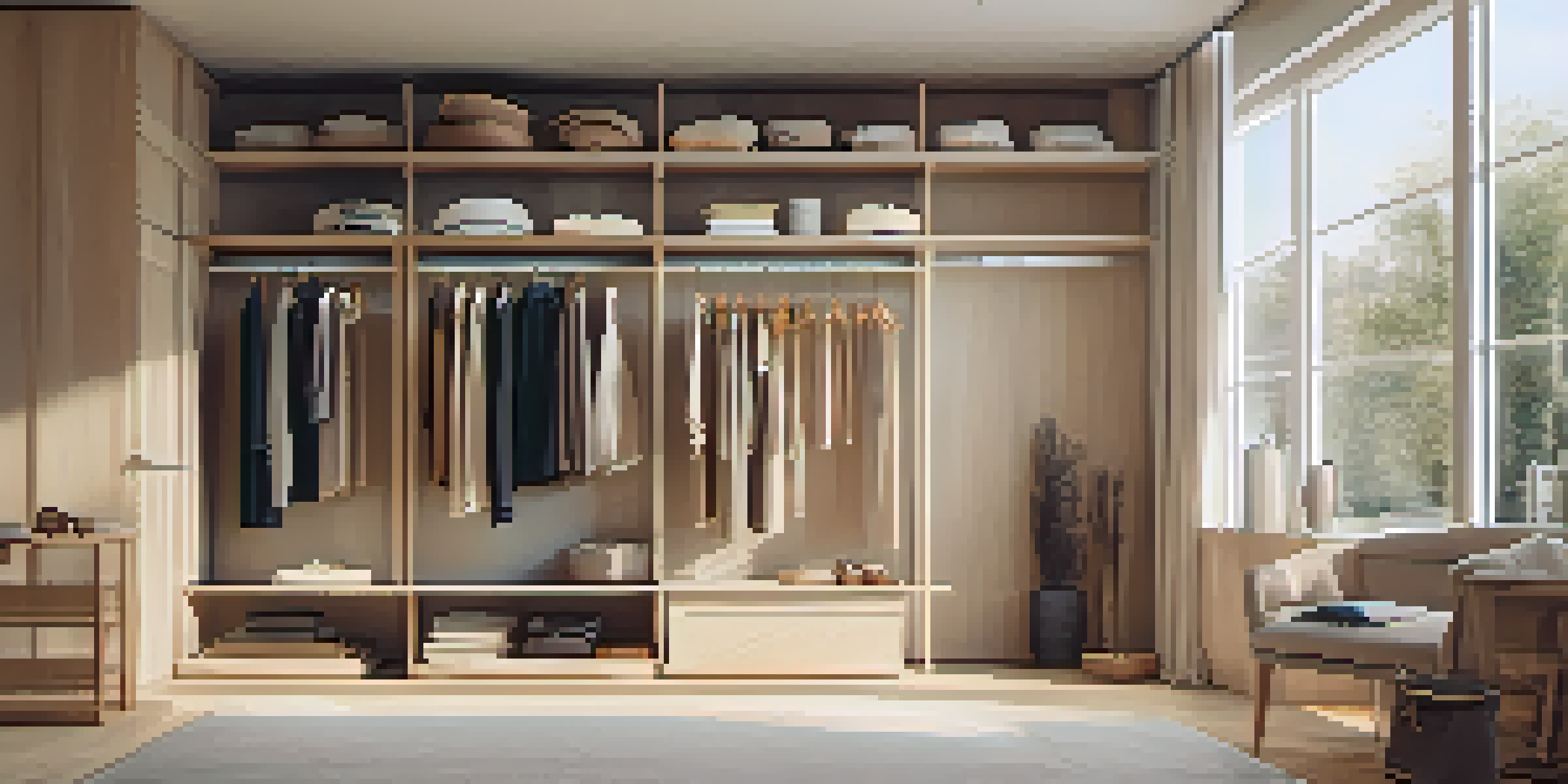The Psychology Behind Minimalism in Fashion Consumption

Defining Minimalism in Fashion Consumption
Minimalism in fashion is about simplifying choices while maximizing style. It emphasizes quality over quantity, encouraging individuals to invest in fewer, high-quality pieces. This trend has gained traction as people seek to declutter their wardrobes and lives, aligning with a more sustainable lifestyle. By focusing on essentials, consumers can express their personal style without overwhelming their closets.
Simplicity is the ultimate sophistication.
For many, minimalism is not just a fashion statement but a lifestyle choice that resonates with their values. It reflects a desire for clarity, simplicity, and intentionality in a world filled with distractions. This shift encourages shoppers to consider what they truly need versus what they want, leading to more mindful consumption habits.
Ultimately, minimalism in fashion consumption is about finding balance. It allows individuals to showcase their personality through curated outfits without the stress of excessive choices. This approach fosters a sense of calm and satisfaction, making it a powerful philosophy in today's fast-paced world.
The Psychological Appeal of Minimalism
The appeal of minimalism lies in its psychological benefits, such as reduced anxiety and increased clarity. By eliminating excess, individuals can focus on what truly matters to them, leading to a more fulfilling life. This reduction in choice can also alleviate decision fatigue, a common issue in our overstimulated society, where too many options can be paralyzing.

Studies show that a cluttered environment can lead to increased stress and dissatisfaction. In contrast, a minimalist wardrobe can create a sense of order and control, which is particularly appealing during chaotic times. By adopting a minimalist approach, consumers often experience a boost in their mental well-being, as they create spaces and styles that reflect their true selves.
Minimalism Prioritizes Quality Choices
Minimalism in fashion encourages individuals to invest in fewer, high-quality pieces, promoting a more sustainable lifestyle.
Moreover, the act of choosing fewer items often results in a deeper appreciation for each piece. This emotional connection fosters a sense of pride in one’s wardrobe, encouraging individuals to wear and cherish their clothing rather than letting pieces languish unworn. This shift can transform the relationship people have with fashion from superficial to meaningful.
Sustainability and Minimalism: A Perfect Match
Minimalism in fashion aligns beautifully with the growing emphasis on sustainability. As consumers become more aware of the environmental impact of fast fashion, many are opting for a minimalist approach that prioritizes eco-friendly choices. This shift not only benefits the planet but also encourages a more ethical consumption pattern.
The less you own, the less that owns you.
By choosing fewer, high-quality pieces, individuals can reduce waste and support brands that prioritize sustainable practices. This conscious decision-making reflects a broader trend towards responsible consumerism, where the focus is on the longevity and lifecycle of clothing. Sustainability becomes an integral part of the minimalist lifestyle, enhancing its appeal.
Additionally, minimalism pushes for a shift away from disposable fashion, encouraging consumers to invest in timeless styles that can be worn for years. This not only reduces fashion-related waste but also fosters a culture of appreciation for craftsmanship and quality. As a result, fashion becomes more than just a trend; it evolves into a thoughtful expression of personal values.
The Role of Social Media in Minimalism
Social media has played a significant role in popularizing minimalism in fashion consumption. Platforms like Instagram and Pinterest showcase minimalist aesthetics, inspiring users to curate their wardrobes and lifestyles. Influencers and fashion icons often advocate for minimalism, highlighting the beauty in simplicity and encouraging followers to adopt similar styles.
These platforms allow individuals to connect over shared values and aesthetics, creating communities centered around minimalism. As users share their minimalist outfits and tips, they foster a sense of belonging and motivation. This collective movement amplifies the appeal of minimalism, making it more accessible and relatable to a broader audience.
Mental Clarity Through Simplicity
Adopting minimalism can reduce anxiety and decision fatigue, fostering a sense of order and control in one’s life.
Moreover, social media serves as a powerful tool for educating consumers about the benefits of minimalism. From decluttering guides to sustainable fashion tips, users can find a wealth of information at their fingertips. This easy access to knowledge empowers individuals to make informed choices, reinforcing the minimalist philosophy in their fashion consumption.
Creating a Minimalist Wardrobe: Steps to Get Started
Starting a minimalist wardrobe requires intentionality and a willingness to let go of excess. The first step is to assess your current clothing collection and identify items that no longer serve you. This process can be both liberating and daunting, but focusing on what brings you joy can guide your decision-making.
Next, consider defining your personal style and the essentials that complement it. Creating a capsule wardrobe, which consists of a limited number of versatile pieces, can simplify daily outfit choices. By choosing items that mix and match easily, you enhance the functionality of your wardrobe while staying true to your minimalist values.
Finally, commit to mindful shopping habits moving forward. Before making a purchase, ask yourself if the item truly fits your style and if it aligns with your minimalist ethos. By cultivating a thoughtful approach to fashion consumption, you will find that your wardrobe becomes a reflection of your values and lifestyle.
Challenges of Embracing Minimalism in Fashion
While minimalism offers numerous benefits, embracing this philosophy can come with its challenges. One significant hurdle is the societal pressure to keep up with trends and consumer culture. The fast-paced nature of fashion can make it difficult for individuals to resist the allure of constant shopping and newness.
Moreover, the emotional attachment to clothing can complicate the process of decluttering. Sentimental pieces or items associated with special memories can be hard to part with, leading to internal conflict. Acknowledging these feelings is essential for overcoming barriers to adopting a minimalist wardrobe.
Social Media Boosts Minimalist Trends
Platforms like Instagram and Pinterest play a crucial role in popularizing minimalism, creating communities that inspire mindful consumption.
Lastly, the misconception that minimalism equates to a lack of style can deter some from pursuing this approach. Many believe that minimalism means dull or boring fashion choices, but this couldn't be further from the truth. In reality, minimalism celebrates creativity within constraints, allowing for unique expressions of personal style that can be both chic and impactful.
The Future of Minimalism in Fashion Consumption
As the world continues to evolve, the future of minimalism in fashion consumption looks promising. With increasing awareness around sustainability and ethical practices, more consumers are likely to seek out minimalist options. This shift could lead to a significant transformation in the fashion industry, prioritizing quality and sustainability over fast fashion.
Brands that embrace minimalism may find a loyal customer base that values transparency and ethical sourcing. As consumers become more discerning, they will gravitate toward companies that align with their values, resulting in a demand for thoughtfully designed collections. This trend could encourage a new era of fashion that prioritizes longevity and responsible consumption.

In conclusion, the psychology behind minimalism in fashion consumption is multifaceted, intertwining personal values, mental well-being, and environmental consciousness. As individuals continue to navigate the complexities of modern life, minimalism offers a refreshing approach that empowers them to make intentional choices. The future is bright for minimalism, as it paves the way for a more sustainable and meaningful fashion landscape.